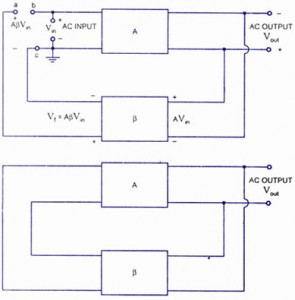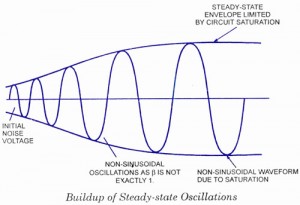How an oscillator operates ?

Related Articles
TRANSISTOR PHASE SHIFT OSCILLATOR
NEGATIVE RESISTANCE OSCILLATORS
To know the basics of oscillators, its frequency stability, types of oscillations, different types of oscillators and so on, use the tag link – OSCILLATORS
A feedback amplifier having closed-loop gain, Af greater than unity can be obtained by the use of a positive feedback. This result also satisfies the phase condition and thus results in the operation of an oscillator circuit. An oscillator circuit then provides a constantly varying output signal. If the output signal varies sinusoidally, the circuit can be called as a sinusoidal oscillator. But, if the output voltage rises and drops from one voltage level to another quickly, the circuit can be called a pulse or square-wave generator.
To understand how an oscillator produces an output signal without an external input signal, let us consider the feedback circuit shown in fig (a). In the figure Vin is the voltage of ac input driving the input terminals B-C of an amplifier having voltage gain A.
The amplified output voltage is Vout = A Vin
This voltage drives a feedback circuit that is usually a resonant circuit, as we get maximum feedback at one frequency. The feedback voltage returning to point a is given by equation Vf = A β Vin where β is the gain of feedback network
If the phase shift through the amplifier and feedback circuit is zero, then A β Vin is in phase with the input signal Vin that drives the input terminals of the amplifier.
 Now we connect point ‘a’ to point ‘b’ and simultaneously remove voltage source Vin, then feedback voltage A β Vin drives the input terminals b c of the amplifier, as shown in fig. (b). In case A β is less than unity, A β Vin is less than Vin and the output signal will die out, as illustrated in second fig. (a). On the other hand if A P is greater than unity, the output signal will build up, as illustrated in second fig. (b). If A β is equal to unity, A β Vin equals Vin and the output signal is a steady sine wave, as illustrated in fig. (c). In this case the circuit supplies its own input signal and produces a sinusoidal output.
Now we connect point ‘a’ to point ‘b’ and simultaneously remove voltage source Vin, then feedback voltage A β Vin drives the input terminals b c of the amplifier, as shown in fig. (b). In case A β is less than unity, A β Vin is less than Vin and the output signal will die out, as illustrated in second fig. (a). On the other hand if A P is greater than unity, the output signal will build up, as illustrated in second fig. (b). If A β is equal to unity, A β Vin equals Vin and the output signal is a steady sine wave, as illustrated in fig. (c). In this case the circuit supplies its own input signal and produces a sinusoidal output.
Certain conditions are required to be fulfilled for sustained oscillations and these conditions are that
(i) The loop gain of the circuit must be equal to (or greater than) unity and
(ii) The phase shift around the circuit must be zero. These two conditions for sustained oscillations are called Barkhausen criteria.
There is no need of an input signal for the initiation of oscillations. In order to obtain a self-sustained oscillation, the condition β A = 1 must be satisfied. The value of β A is made greater than unity. As a result the system starts oscillating by amplifying noise voltage which is always present. An average value of β A of 1 can be obtained by the saturation factors in the practical circuits. The waveforms that are obtained will not be exactly sinusoidal. If the value of β A is closer to the value 1, the waveform becomes more sinusoidal. The figure above shows how the noise voltage results in a build up of a steady state oscillation condition.
By noting the denominator in the feedback equation, we can see the way the feedback circuit operates as an oscillator.
Af= A / 1 + β A. When β A = -1 or magnitude 1 at a phase angle of 180°,
The gain with feedback, Af becomes infinite as the denominator becomes zero. Thus, a measurable output voltage can be obtained with the help of an infinite signal (noise voltage), and the circuit acts as an oscillator even without an input signal.
At the resonant frequency, the phase shift around the loop is made 0° by deliberate design. The phase shift is different from 0° above and below the resonant frequency. Thus, the resonant frequency of the feedback circuit will be the only frequency where the oscillations will be obtained.


6 Comments
yeah d same as in text,,,,, but cool ,neways
helps
thank u very much,i got what i need